Royal Bank of Scotland: Making Sense of Organisations Report
VerifiedAdded on 2020/06/06
|18
|5064
|309
Report
AI Summary
This report analyzes the impact of culture on organizations, particularly within the context of the Royal Bank of Scotland's joint venture with German and Chinese banks. It explores the importance of understanding cultural differences, especially given the diverse teams from the UK, Germany, and China involved in the project. The report delves into the meaning of culture, the significance of Hofstede's cultural dimensions, and the application of this model to team dynamics. It highlights the need for cross-cultural training and development to address potential conflicts arising from differing values and working styles. Furthermore, the report examines the concept of behavioral modification and the main concerns of cross-cultural management, providing insights into how to navigate the complexities of a globalized work environment. The report also presents detailed comparisons between the UK and China across Hofstede's dimensions, offering practical implications for managing teams and fostering effective collaboration in a multicultural setting.
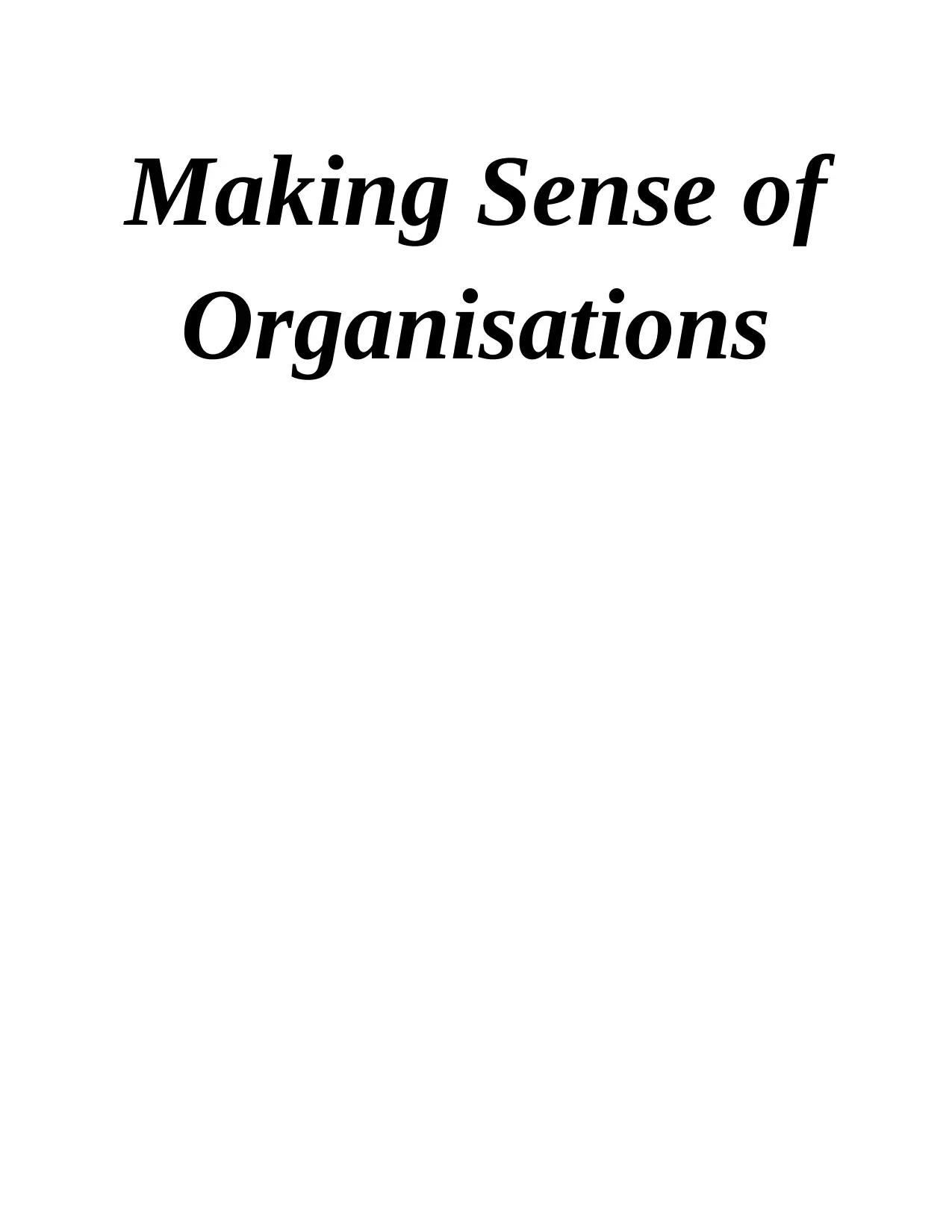
Making Sense of
Organisations
Organisations
Paraphrase This Document
Need a fresh take? Get an instant paraphrase of this document with our AI Paraphraser
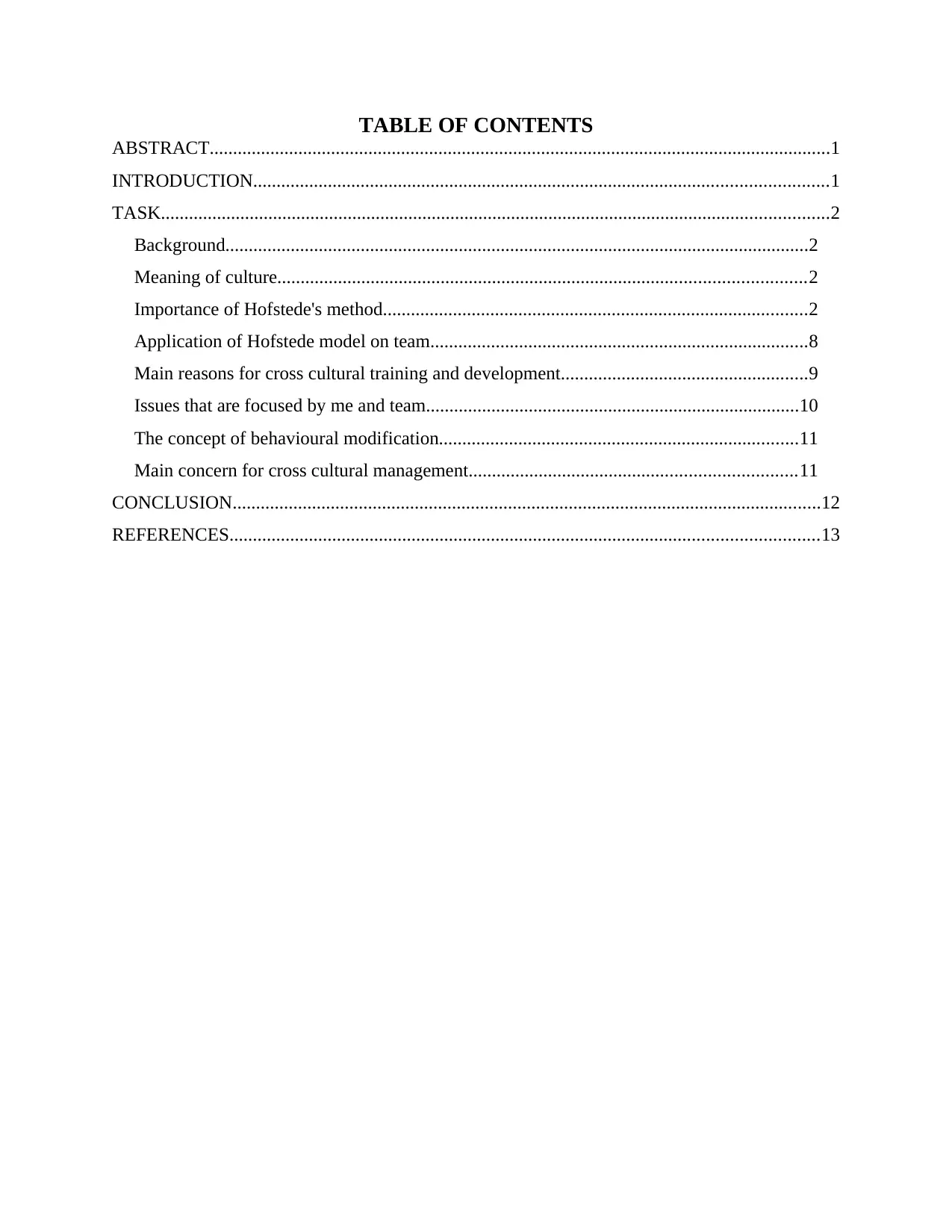
TABLE OF CONTENTS
ABSTRACT.....................................................................................................................................1
INTRODUCTION...........................................................................................................................1
TASK...............................................................................................................................................2
Background.............................................................................................................................2
Meaning of culture.................................................................................................................2
Importance of Hofstede's method...........................................................................................2
Application of Hofstede model on team.................................................................................8
Main reasons for cross cultural training and development.....................................................9
Issues that are focused by me and team................................................................................10
The concept of behavioural modification.............................................................................11
Main concern for cross cultural management......................................................................11
CONCLUSION..............................................................................................................................12
REFERENCES..............................................................................................................................13
ABSTRACT.....................................................................................................................................1
INTRODUCTION...........................................................................................................................1
TASK...............................................................................................................................................2
Background.............................................................................................................................2
Meaning of culture.................................................................................................................2
Importance of Hofstede's method...........................................................................................2
Application of Hofstede model on team.................................................................................8
Main reasons for cross cultural training and development.....................................................9
Issues that are focused by me and team................................................................................10
The concept of behavioural modification.............................................................................11
Main concern for cross cultural management......................................................................11
CONCLUSION..............................................................................................................................12
REFERENCES..............................................................................................................................13
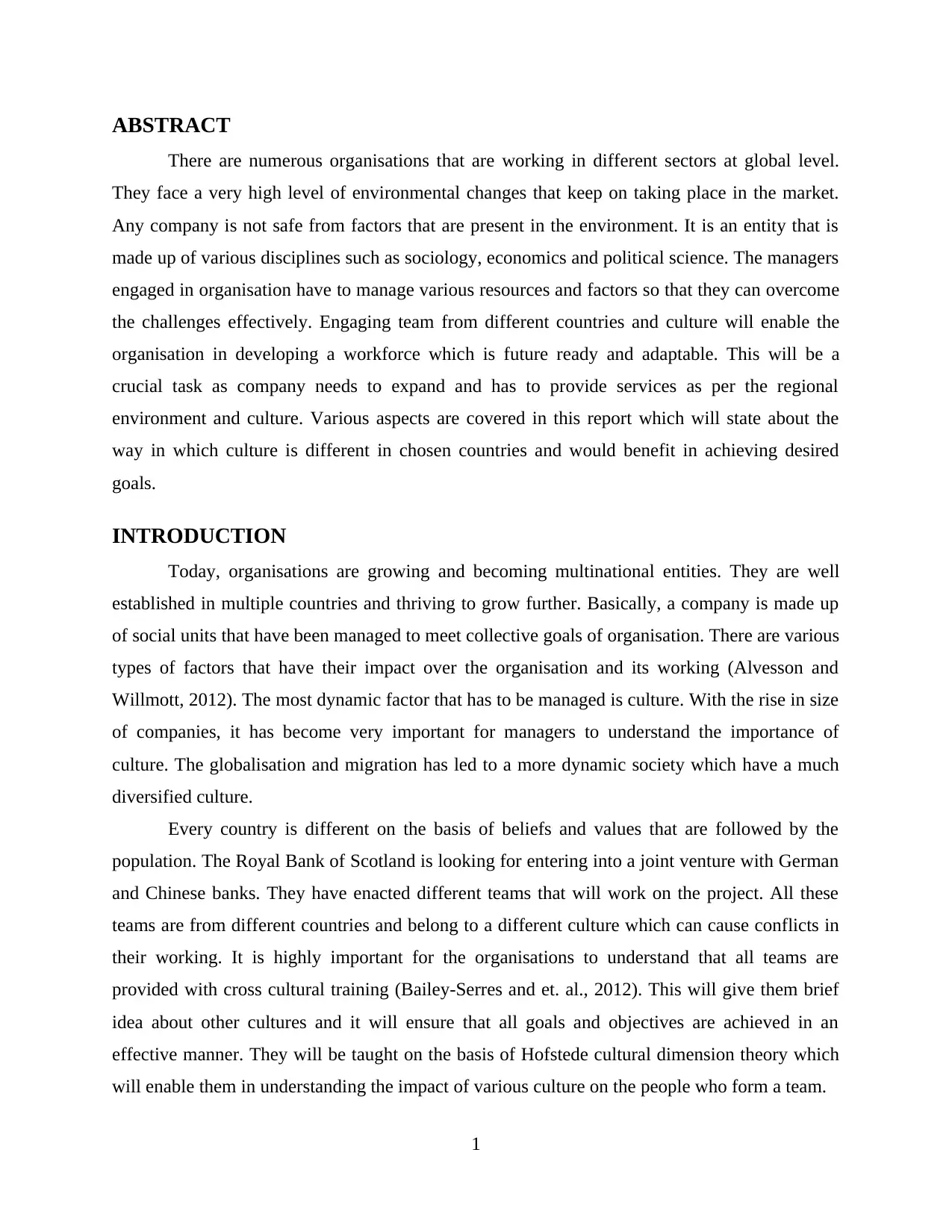
ABSTRACT
There are numerous organisations that are working in different sectors at global level.
They face a very high level of environmental changes that keep on taking place in the market.
Any company is not safe from factors that are present in the environment. It is an entity that is
made up of various disciplines such as sociology, economics and political science. The managers
engaged in organisation have to manage various resources and factors so that they can overcome
the challenges effectively. Engaging team from different countries and culture will enable the
organisation in developing a workforce which is future ready and adaptable. This will be a
crucial task as company needs to expand and has to provide services as per the regional
environment and culture. Various aspects are covered in this report which will state about the
way in which culture is different in chosen countries and would benefit in achieving desired
goals.
INTRODUCTION
Today, organisations are growing and becoming multinational entities. They are well
established in multiple countries and thriving to grow further. Basically, a company is made up
of social units that have been managed to meet collective goals of organisation. There are various
types of factors that have their impact over the organisation and its working (Alvesson and
Willmott, 2012). The most dynamic factor that has to be managed is culture. With the rise in size
of companies, it has become very important for managers to understand the importance of
culture. The globalisation and migration has led to a more dynamic society which have a much
diversified culture.
Every country is different on the basis of beliefs and values that are followed by the
population. The Royal Bank of Scotland is looking for entering into a joint venture with German
and Chinese banks. They have enacted different teams that will work on the project. All these
teams are from different countries and belong to a different culture which can cause conflicts in
their working. It is highly important for the organisations to understand that all teams are
provided with cross cultural training (Bailey-Serres and et. al., 2012). This will give them brief
idea about other cultures and it will ensure that all goals and objectives are achieved in an
effective manner. They will be taught on the basis of Hofstede cultural dimension theory which
will enable them in understanding the impact of various culture on the people who form a team.
1
There are numerous organisations that are working in different sectors at global level.
They face a very high level of environmental changes that keep on taking place in the market.
Any company is not safe from factors that are present in the environment. It is an entity that is
made up of various disciplines such as sociology, economics and political science. The managers
engaged in organisation have to manage various resources and factors so that they can overcome
the challenges effectively. Engaging team from different countries and culture will enable the
organisation in developing a workforce which is future ready and adaptable. This will be a
crucial task as company needs to expand and has to provide services as per the regional
environment and culture. Various aspects are covered in this report which will state about the
way in which culture is different in chosen countries and would benefit in achieving desired
goals.
INTRODUCTION
Today, organisations are growing and becoming multinational entities. They are well
established in multiple countries and thriving to grow further. Basically, a company is made up
of social units that have been managed to meet collective goals of organisation. There are various
types of factors that have their impact over the organisation and its working (Alvesson and
Willmott, 2012). The most dynamic factor that has to be managed is culture. With the rise in size
of companies, it has become very important for managers to understand the importance of
culture. The globalisation and migration has led to a more dynamic society which have a much
diversified culture.
Every country is different on the basis of beliefs and values that are followed by the
population. The Royal Bank of Scotland is looking for entering into a joint venture with German
and Chinese banks. They have enacted different teams that will work on the project. All these
teams are from different countries and belong to a different culture which can cause conflicts in
their working. It is highly important for the organisations to understand that all teams are
provided with cross cultural training (Bailey-Serres and et. al., 2012). This will give them brief
idea about other cultures and it will ensure that all goals and objectives are achieved in an
effective manner. They will be taught on the basis of Hofstede cultural dimension theory which
will enable them in understanding the impact of various culture on the people who form a team.
1
⊘ This is a preview!⊘
Do you want full access?
Subscribe today to unlock all pages.

Trusted by 1+ million students worldwide
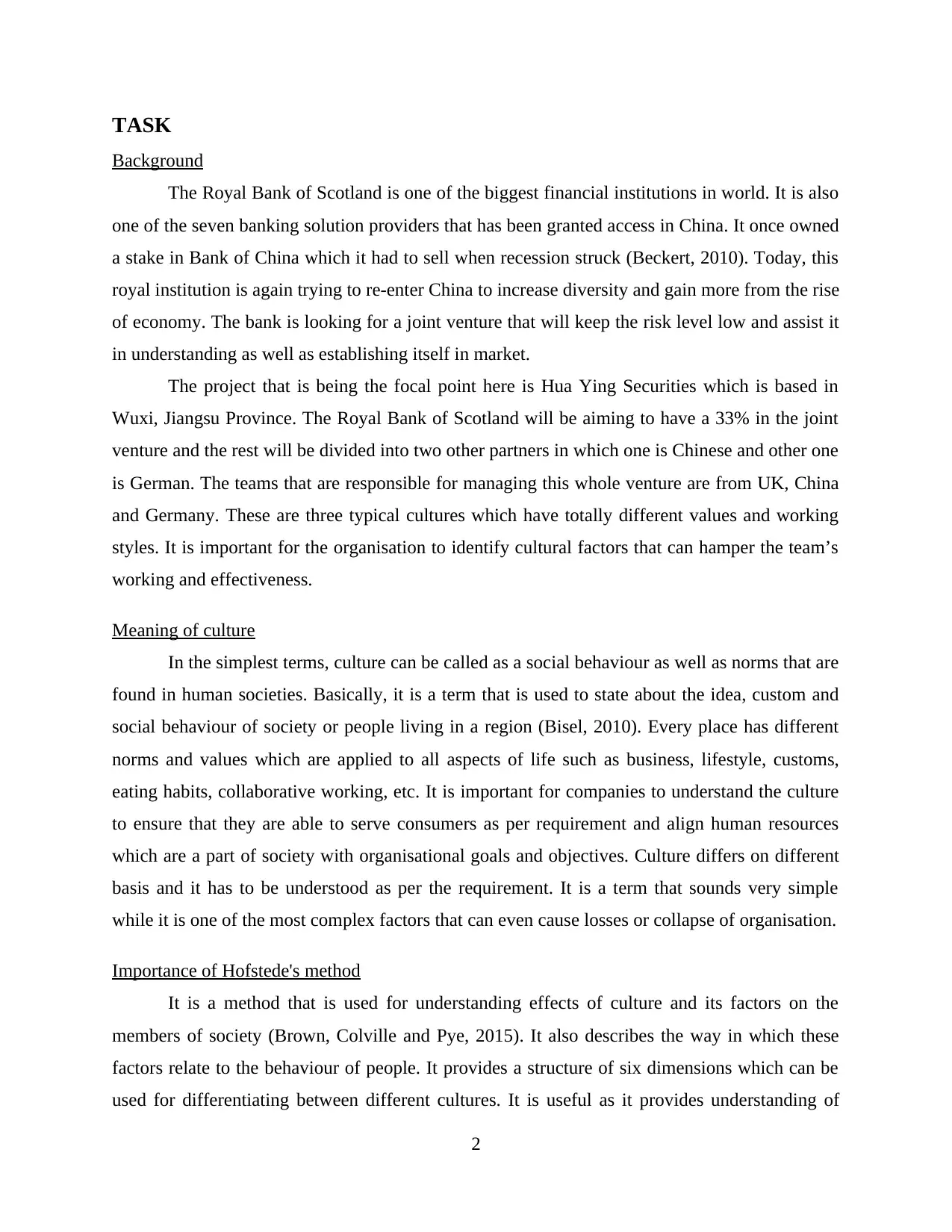
TASK
Background
The Royal Bank of Scotland is one of the biggest financial institutions in world. It is also
one of the seven banking solution providers that has been granted access in China. It once owned
a stake in Bank of China which it had to sell when recession struck (Beckert, 2010). Today, this
royal institution is again trying to re-enter China to increase diversity and gain more from the rise
of economy. The bank is looking for a joint venture that will keep the risk level low and assist it
in understanding as well as establishing itself in market.
The project that is being the focal point here is Hua Ying Securities which is based in
Wuxi, Jiangsu Province. The Royal Bank of Scotland will be aiming to have a 33% in the joint
venture and the rest will be divided into two other partners in which one is Chinese and other one
is German. The teams that are responsible for managing this whole venture are from UK, China
and Germany. These are three typical cultures which have totally different values and working
styles. It is important for the organisation to identify cultural factors that can hamper the team’s
working and effectiveness.
Meaning of culture
In the simplest terms, culture can be called as a social behaviour as well as norms that are
found in human societies. Basically, it is a term that is used to state about the idea, custom and
social behaviour of society or people living in a region (Bisel, 2010). Every place has different
norms and values which are applied to all aspects of life such as business, lifestyle, customs,
eating habits, collaborative working, etc. It is important for companies to understand the culture
to ensure that they are able to serve consumers as per requirement and align human resources
which are a part of society with organisational goals and objectives. Culture differs on different
basis and it has to be understood as per the requirement. It is a term that sounds very simple
while it is one of the most complex factors that can even cause losses or collapse of organisation.
Importance of Hofstede's method
It is a method that is used for understanding effects of culture and its factors on the
members of society (Brown, Colville and Pye, 2015). It also describes the way in which these
factors relate to the behaviour of people. It provides a structure of six dimensions which can be
used for differentiating between different cultures. It is useful as it provides understanding of
2
Background
The Royal Bank of Scotland is one of the biggest financial institutions in world. It is also
one of the seven banking solution providers that has been granted access in China. It once owned
a stake in Bank of China which it had to sell when recession struck (Beckert, 2010). Today, this
royal institution is again trying to re-enter China to increase diversity and gain more from the rise
of economy. The bank is looking for a joint venture that will keep the risk level low and assist it
in understanding as well as establishing itself in market.
The project that is being the focal point here is Hua Ying Securities which is based in
Wuxi, Jiangsu Province. The Royal Bank of Scotland will be aiming to have a 33% in the joint
venture and the rest will be divided into two other partners in which one is Chinese and other one
is German. The teams that are responsible for managing this whole venture are from UK, China
and Germany. These are three typical cultures which have totally different values and working
styles. It is important for the organisation to identify cultural factors that can hamper the team’s
working and effectiveness.
Meaning of culture
In the simplest terms, culture can be called as a social behaviour as well as norms that are
found in human societies. Basically, it is a term that is used to state about the idea, custom and
social behaviour of society or people living in a region (Bisel, 2010). Every place has different
norms and values which are applied to all aspects of life such as business, lifestyle, customs,
eating habits, collaborative working, etc. It is important for companies to understand the culture
to ensure that they are able to serve consumers as per requirement and align human resources
which are a part of society with organisational goals and objectives. Culture differs on different
basis and it has to be understood as per the requirement. It is a term that sounds very simple
while it is one of the most complex factors that can even cause losses or collapse of organisation.
Importance of Hofstede's method
It is a method that is used for understanding effects of culture and its factors on the
members of society (Brown, Colville and Pye, 2015). It also describes the way in which these
factors relate to the behaviour of people. It provides a structure of six dimensions which can be
used for differentiating between different cultures. It is useful as it provides understanding of
2
Paraphrase This Document
Need a fresh take? Get an instant paraphrase of this document with our AI Paraphraser
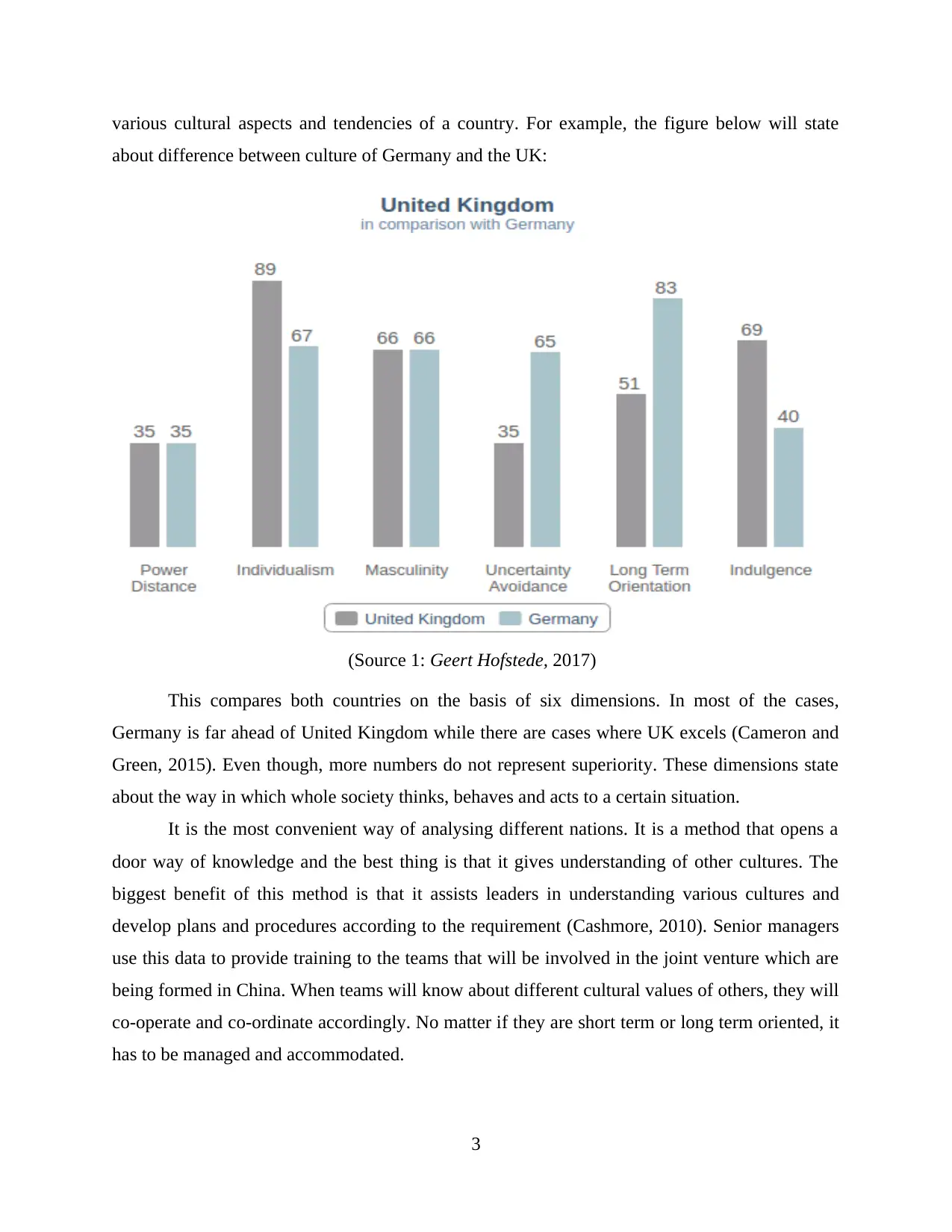
various cultural aspects and tendencies of a country. For example, the figure below will state
about difference between culture of Germany and the UK:
(Source 1: Geert Hofstede, 2017)
This compares both countries on the basis of six dimensions. In most of the cases,
Germany is far ahead of United Kingdom while there are cases where UK excels (Cameron and
Green, 2015). Even though, more numbers do not represent superiority. These dimensions state
about the way in which whole society thinks, behaves and acts to a certain situation.
It is the most convenient way of analysing different nations. It is a method that opens a
door way of knowledge and the best thing is that it gives understanding of other cultures. The
biggest benefit of this method is that it assists leaders in understanding various cultures and
develop plans and procedures according to the requirement (Cashmore, 2010). Senior managers
use this data to provide training to the teams that will be involved in the joint venture which are
being formed in China. When teams will know about different cultural values of others, they will
co-operate and co-ordinate accordingly. No matter if they are short term or long term oriented, it
has to be managed and accommodated.
3
about difference between culture of Germany and the UK:
(Source 1: Geert Hofstede, 2017)
This compares both countries on the basis of six dimensions. In most of the cases,
Germany is far ahead of United Kingdom while there are cases where UK excels (Cameron and
Green, 2015). Even though, more numbers do not represent superiority. These dimensions state
about the way in which whole society thinks, behaves and acts to a certain situation.
It is the most convenient way of analysing different nations. It is a method that opens a
door way of knowledge and the best thing is that it gives understanding of other cultures. The
biggest benefit of this method is that it assists leaders in understanding various cultures and
develop plans and procedures according to the requirement (Cashmore, 2010). Senior managers
use this data to provide training to the teams that will be involved in the joint venture which are
being formed in China. When teams will know about different cultural values of others, they will
co-operate and co-ordinate accordingly. No matter if they are short term or long term oriented, it
has to be managed and accommodated.
3
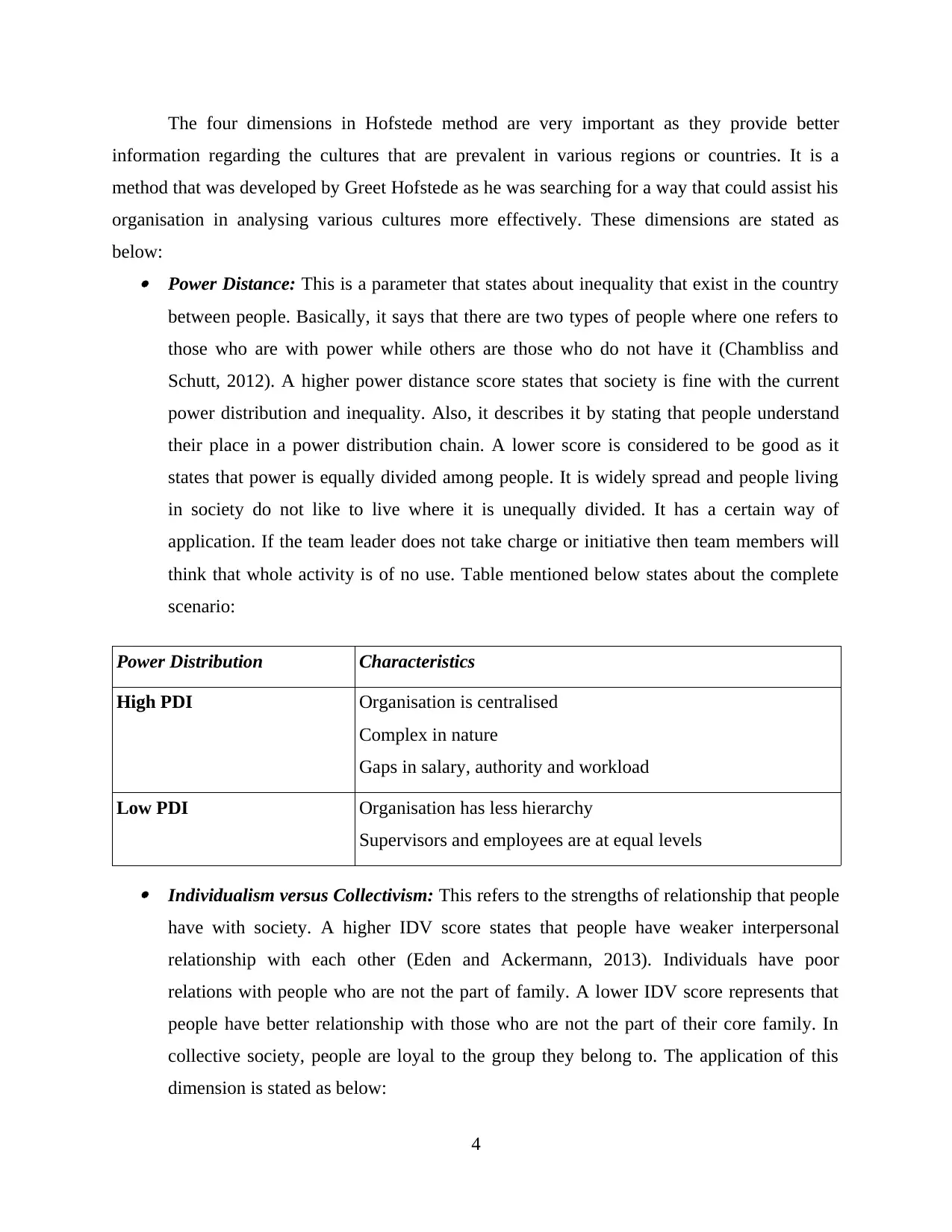
The four dimensions in Hofstede method are very important as they provide better
information regarding the cultures that are prevalent in various regions or countries. It is a
method that was developed by Greet Hofstede as he was searching for a way that could assist his
organisation in analysing various cultures more effectively. These dimensions are stated as
below: Power Distance: This is a parameter that states about inequality that exist in the country
between people. Basically, it says that there are two types of people where one refers to
those who are with power while others are those who do not have it (Chambliss and
Schutt, 2012). A higher power distance score states that society is fine with the current
power distribution and inequality. Also, it describes it by stating that people understand
their place in a power distribution chain. A lower score is considered to be good as it
states that power is equally divided among people. It is widely spread and people living
in society do not like to live where it is unequally divided. It has a certain way of
application. If the team leader does not take charge or initiative then team members will
think that whole activity is of no use. Table mentioned below states about the complete
scenario:
Power Distribution Characteristics
High PDI Organisation is centralised
Complex in nature
Gaps in salary, authority and workload
Low PDI Organisation has less hierarchy
Supervisors and employees are at equal levels
Individualism versus Collectivism: This refers to the strengths of relationship that people
have with society. A higher IDV score states that people have weaker interpersonal
relationship with each other (Eden and Ackermann, 2013). Individuals have poor
relations with people who are not the part of family. A lower IDV score represents that
people have better relationship with those who are not the part of their core family. In
collective society, people are loyal to the group they belong to. The application of this
dimension is stated as below:
4
information regarding the cultures that are prevalent in various regions or countries. It is a
method that was developed by Greet Hofstede as he was searching for a way that could assist his
organisation in analysing various cultures more effectively. These dimensions are stated as
below: Power Distance: This is a parameter that states about inequality that exist in the country
between people. Basically, it says that there are two types of people where one refers to
those who are with power while others are those who do not have it (Chambliss and
Schutt, 2012). A higher power distance score states that society is fine with the current
power distribution and inequality. Also, it describes it by stating that people understand
their place in a power distribution chain. A lower score is considered to be good as it
states that power is equally divided among people. It is widely spread and people living
in society do not like to live where it is unequally divided. It has a certain way of
application. If the team leader does not take charge or initiative then team members will
think that whole activity is of no use. Table mentioned below states about the complete
scenario:
Power Distribution Characteristics
High PDI Organisation is centralised
Complex in nature
Gaps in salary, authority and workload
Low PDI Organisation has less hierarchy
Supervisors and employees are at equal levels
Individualism versus Collectivism: This refers to the strengths of relationship that people
have with society. A higher IDV score states that people have weaker interpersonal
relationship with each other (Eden and Ackermann, 2013). Individuals have poor
relations with people who are not the part of family. A lower IDV score represents that
people have better relationship with those who are not the part of their core family. In
collective society, people are loyal to the group they belong to. The application of this
dimension is stated as below:
4
⊘ This is a preview!⊘
Do you want full access?
Subscribe today to unlock all pages.

Trusted by 1+ million students worldwide
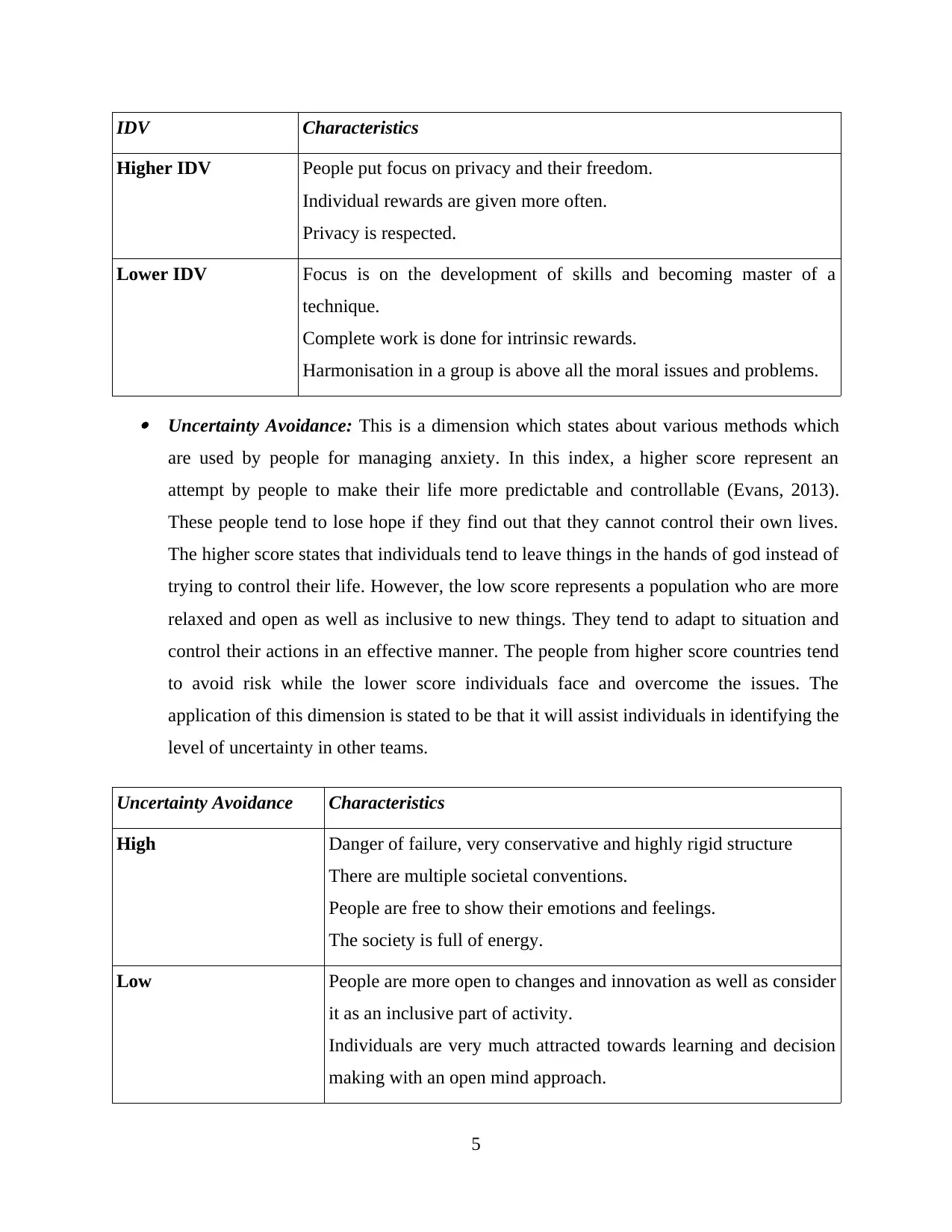
IDV Characteristics
Higher IDV People put focus on privacy and their freedom.
Individual rewards are given more often.
Privacy is respected.
Lower IDV Focus is on the development of skills and becoming master of a
technique.
Complete work is done for intrinsic rewards.
Harmonisation in a group is above all the moral issues and problems.
Uncertainty Avoidance: This is a dimension which states about various methods which
are used by people for managing anxiety. In this index, a higher score represent an
attempt by people to make their life more predictable and controllable (Evans, 2013).
These people tend to lose hope if they find out that they cannot control their own lives.
The higher score states that individuals tend to leave things in the hands of god instead of
trying to control their life. However, the low score represents a population who are more
relaxed and open as well as inclusive to new things. They tend to adapt to situation and
control their actions in an effective manner. The people from higher score countries tend
to avoid risk while the lower score individuals face and overcome the issues. The
application of this dimension is stated to be that it will assist individuals in identifying the
level of uncertainty in other teams.
Uncertainty Avoidance Characteristics
High Danger of failure, very conservative and highly rigid structure
There are multiple societal conventions.
People are free to show their emotions and feelings.
The society is full of energy.
Low People are more open to changes and innovation as well as consider
it as an inclusive part of activity.
Individuals are very much attracted towards learning and decision
making with an open mind approach.
5
Higher IDV People put focus on privacy and their freedom.
Individual rewards are given more often.
Privacy is respected.
Lower IDV Focus is on the development of skills and becoming master of a
technique.
Complete work is done for intrinsic rewards.
Harmonisation in a group is above all the moral issues and problems.
Uncertainty Avoidance: This is a dimension which states about various methods which
are used by people for managing anxiety. In this index, a higher score represent an
attempt by people to make their life more predictable and controllable (Evans, 2013).
These people tend to lose hope if they find out that they cannot control their own lives.
The higher score states that individuals tend to leave things in the hands of god instead of
trying to control their life. However, the low score represents a population who are more
relaxed and open as well as inclusive to new things. They tend to adapt to situation and
control their actions in an effective manner. The people from higher score countries tend
to avoid risk while the lower score individuals face and overcome the issues. The
application of this dimension is stated to be that it will assist individuals in identifying the
level of uncertainty in other teams.
Uncertainty Avoidance Characteristics
High Danger of failure, very conservative and highly rigid structure
There are multiple societal conventions.
People are free to show their emotions and feelings.
The society is full of energy.
Low People are more open to changes and innovation as well as consider
it as an inclusive part of activity.
Individuals are very much attracted towards learning and decision
making with an open mind approach.
5
Paraphrase This Document
Need a fresh take? Get an instant paraphrase of this document with our AI Paraphraser
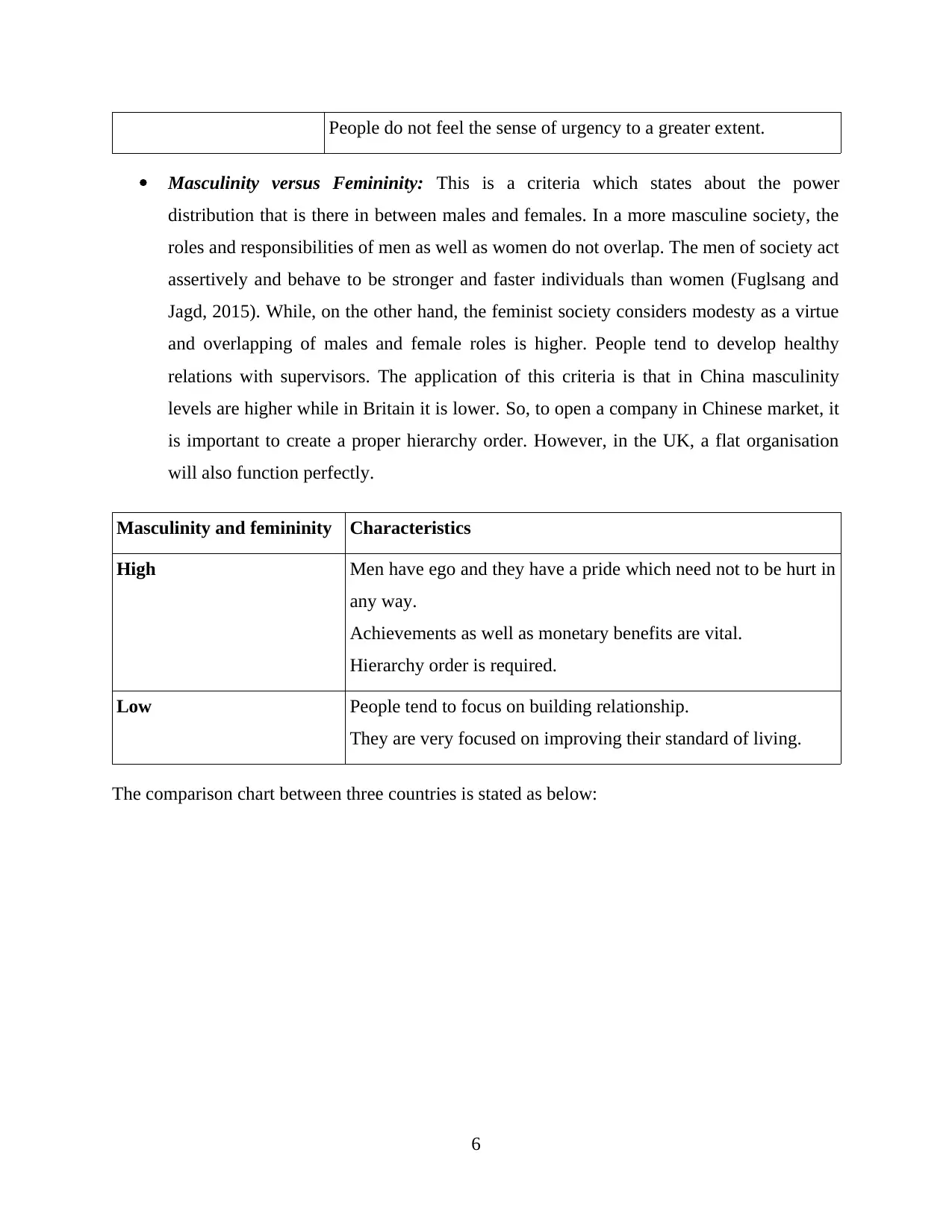
People do not feel the sense of urgency to a greater extent.
Masculinity versus Femininity: This is a criteria which states about the power
distribution that is there in between males and females. In a more masculine society, the
roles and responsibilities of men as well as women do not overlap. The men of society act
assertively and behave to be stronger and faster individuals than women (Fuglsang and
Jagd, 2015). While, on the other hand, the feminist society considers modesty as a virtue
and overlapping of males and female roles is higher. People tend to develop healthy
relations with supervisors. The application of this criteria is that in China masculinity
levels are higher while in Britain it is lower. So, to open a company in Chinese market, it
is important to create a proper hierarchy order. However, in the UK, a flat organisation
will also function perfectly.
Masculinity and femininity Characteristics
High Men have ego and they have a pride which need not to be hurt in
any way.
Achievements as well as monetary benefits are vital.
Hierarchy order is required.
Low People tend to focus on building relationship.
They are very focused on improving their standard of living.
The comparison chart between three countries is stated as below:
6
Masculinity versus Femininity: This is a criteria which states about the power
distribution that is there in between males and females. In a more masculine society, the
roles and responsibilities of men as well as women do not overlap. The men of society act
assertively and behave to be stronger and faster individuals than women (Fuglsang and
Jagd, 2015). While, on the other hand, the feminist society considers modesty as a virtue
and overlapping of males and female roles is higher. People tend to develop healthy
relations with supervisors. The application of this criteria is that in China masculinity
levels are higher while in Britain it is lower. So, to open a company in Chinese market, it
is important to create a proper hierarchy order. However, in the UK, a flat organisation
will also function perfectly.
Masculinity and femininity Characteristics
High Men have ego and they have a pride which need not to be hurt in
any way.
Achievements as well as monetary benefits are vital.
Hierarchy order is required.
Low People tend to focus on building relationship.
They are very focused on improving their standard of living.
The comparison chart between three countries is stated as below:
6
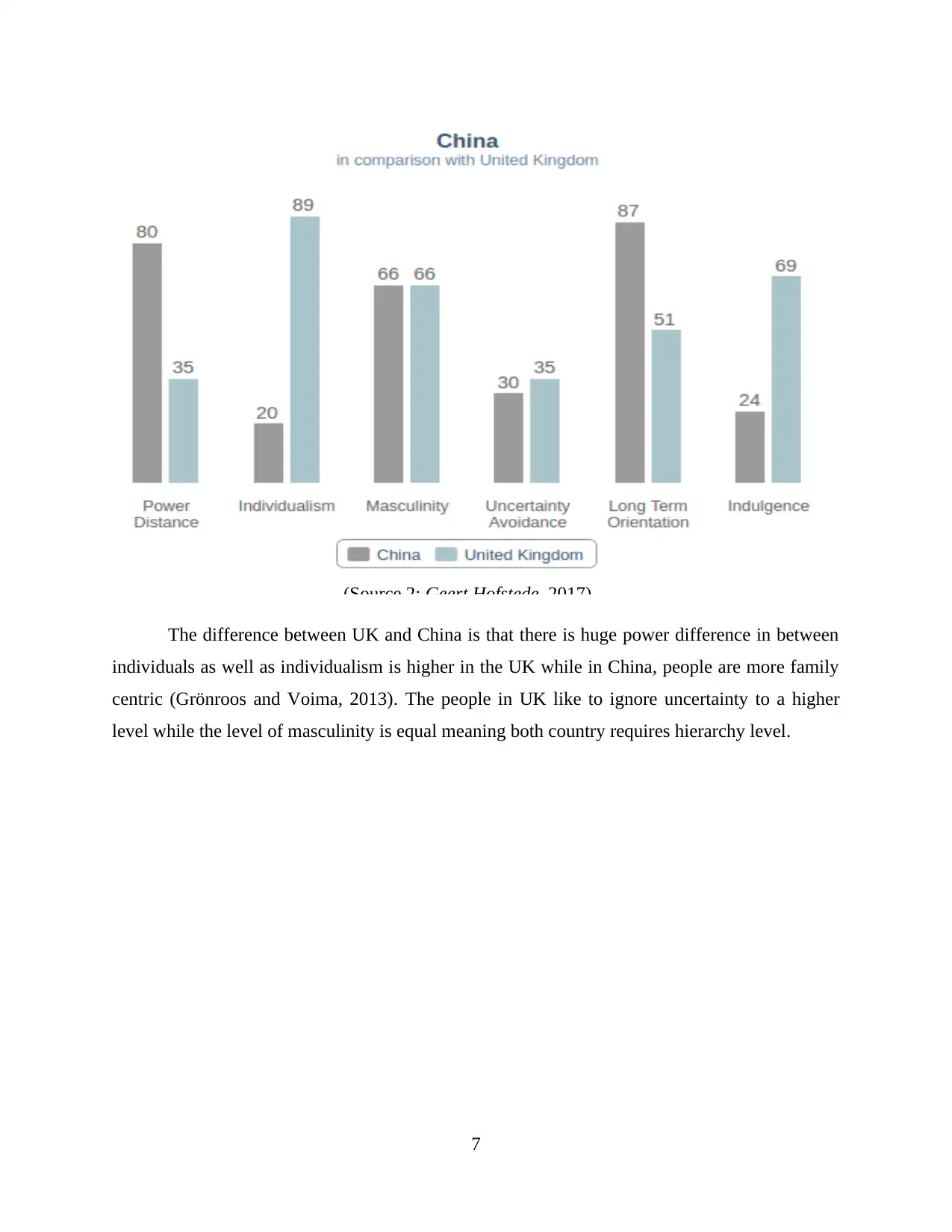
(Source 2: Geert Hofstede, 2017)
The difference between UK and China is that there is huge power difference in between
individuals as well as individualism is higher in the UK while in China, people are more family
centric (Grönroos and Voima, 2013). The people in UK like to ignore uncertainty to a higher
level while the level of masculinity is equal meaning both country requires hierarchy level.
7
The difference between UK and China is that there is huge power difference in between
individuals as well as individualism is higher in the UK while in China, people are more family
centric (Grönroos and Voima, 2013). The people in UK like to ignore uncertainty to a higher
level while the level of masculinity is equal meaning both country requires hierarchy level.
7
⊘ This is a preview!⊘
Do you want full access?
Subscribe today to unlock all pages.

Trusted by 1+ million students worldwide
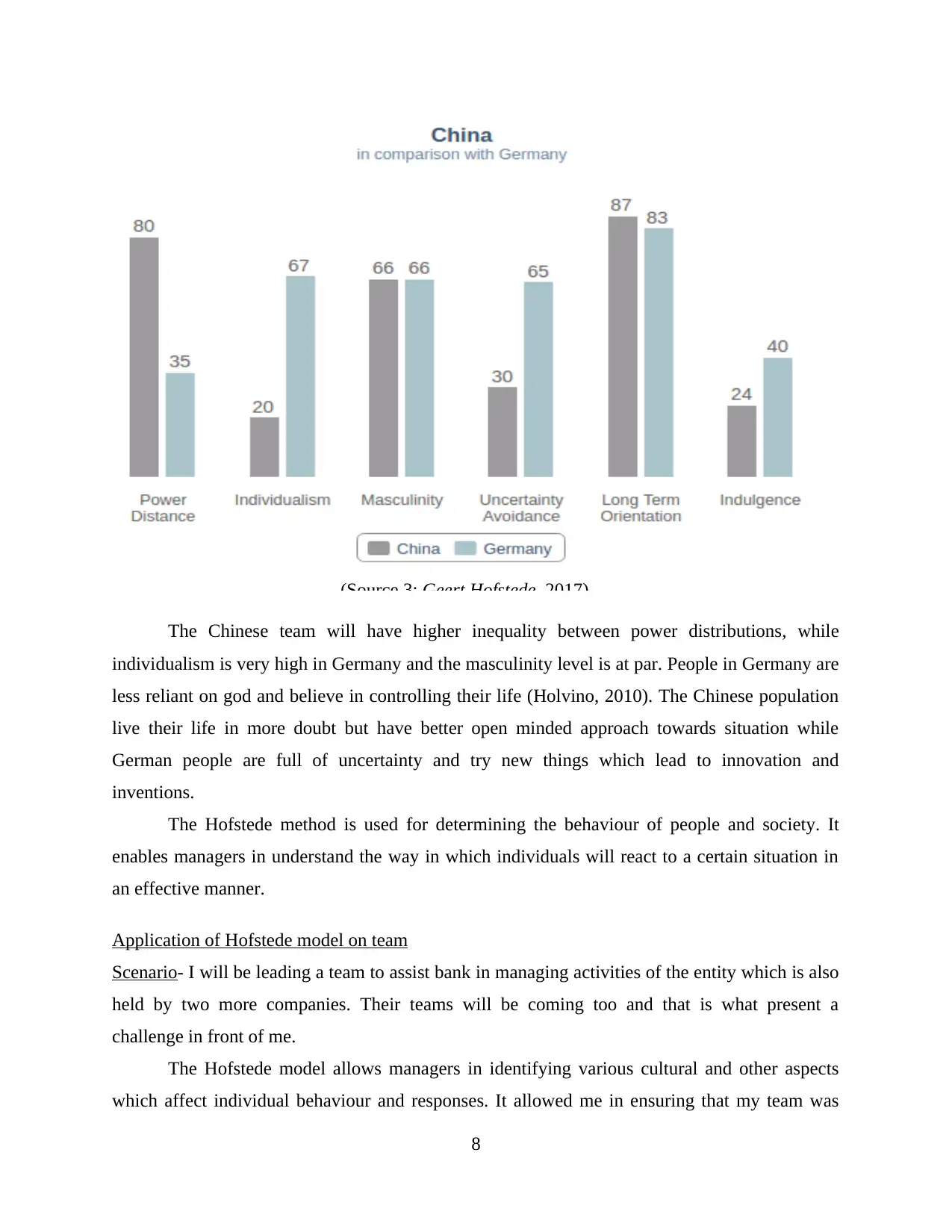
(Source 3: Geert Hofstede, 2017)
The Chinese team will have higher inequality between power distributions, while
individualism is very high in Germany and the masculinity level is at par. People in Germany are
less reliant on god and believe in controlling their life (Holvino, 2010). The Chinese population
live their life in more doubt but have better open minded approach towards situation while
German people are full of uncertainty and try new things which lead to innovation and
inventions.
The Hofstede method is used for determining the behaviour of people and society. It
enables managers in understand the way in which individuals will react to a certain situation in
an effective manner.
Application of Hofstede model on team
Scenario- I will be leading a team to assist bank in managing activities of the entity which is also
held by two more companies. Their teams will be coming too and that is what present a
challenge in front of me.
The Hofstede model allows managers in identifying various cultural and other aspects
which affect individual behaviour and responses. It allowed me in ensuring that my team was
8
The Chinese team will have higher inequality between power distributions, while
individualism is very high in Germany and the masculinity level is at par. People in Germany are
less reliant on god and believe in controlling their life (Holvino, 2010). The Chinese population
live their life in more doubt but have better open minded approach towards situation while
German people are full of uncertainty and try new things which lead to innovation and
inventions.
The Hofstede method is used for determining the behaviour of people and society. It
enables managers in understand the way in which individuals will react to a certain situation in
an effective manner.
Application of Hofstede model on team
Scenario- I will be leading a team to assist bank in managing activities of the entity which is also
held by two more companies. Their teams will be coming too and that is what present a
challenge in front of me.
The Hofstede model allows managers in identifying various cultural and other aspects
which affect individual behaviour and responses. It allowed me in ensuring that my team was
8
Paraphrase This Document
Need a fresh take? Get an instant paraphrase of this document with our AI Paraphraser
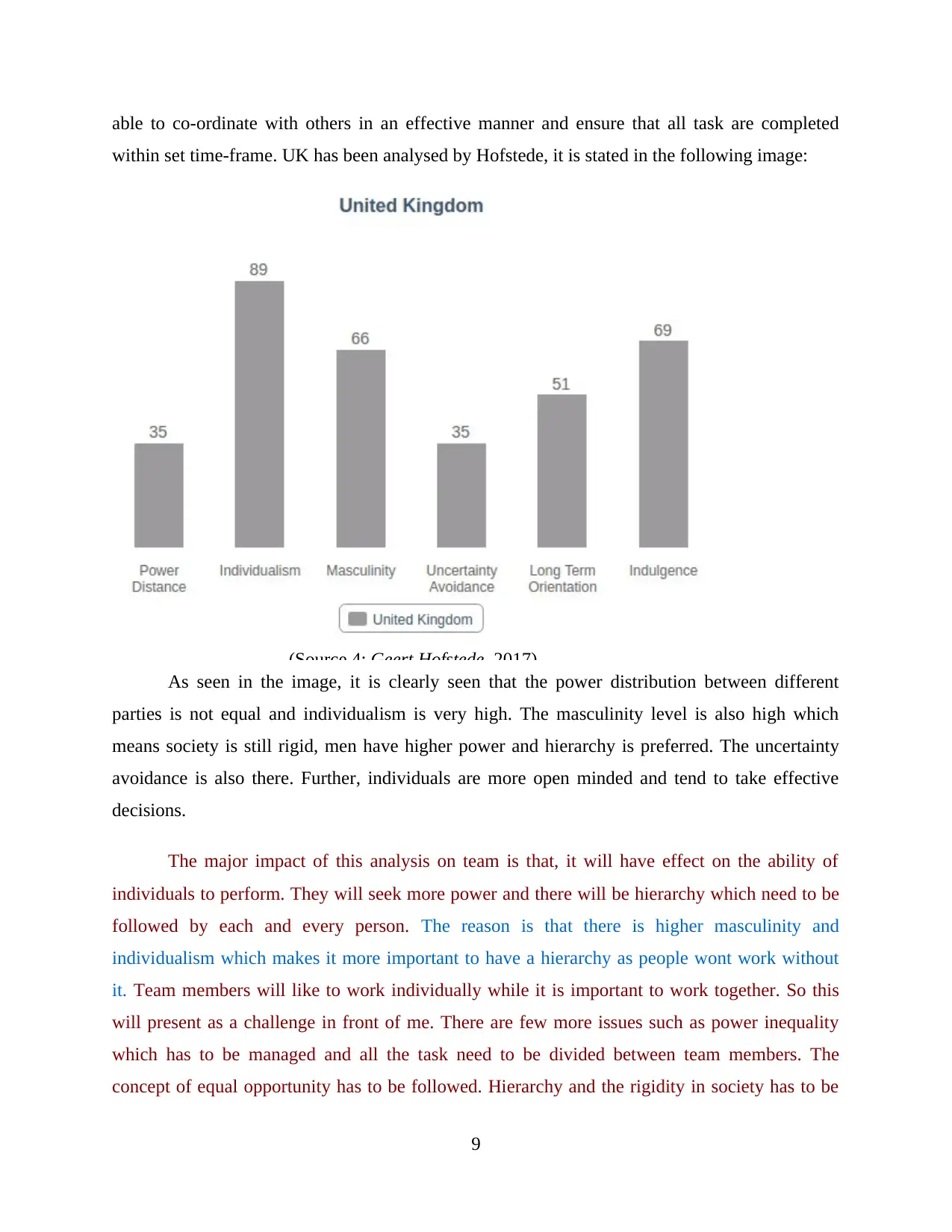
able to co-ordinate with others in an effective manner and ensure that all task are completed
within set time-frame. UK has been analysed by Hofstede, it is stated in the following image:
As seen in the image, it is clearly seen that the power distribution between different
parties is not equal and individualism is very high. The masculinity level is also high which
means society is still rigid, men have higher power and hierarchy is preferred. The uncertainty
avoidance is also there. Further, individuals are more open minded and tend to take effective
decisions.
The major impact of this analysis on team is that, it will have effect on the ability of
individuals to perform. They will seek more power and there will be hierarchy which need to be
followed by each and every person. The reason is that there is higher masculinity and
individualism which makes it more important to have a hierarchy as people wont work without
it. Team members will like to work individually while it is important to work together. So this
will present as a challenge in front of me. There are few more issues such as power inequality
which has to be managed and all the task need to be divided between team members. The
concept of equal opportunity has to be followed. Hierarchy and the rigidity in society has to be
9
(Source 4: Geert Hofstede, 2017)
within set time-frame. UK has been analysed by Hofstede, it is stated in the following image:
As seen in the image, it is clearly seen that the power distribution between different
parties is not equal and individualism is very high. The masculinity level is also high which
means society is still rigid, men have higher power and hierarchy is preferred. The uncertainty
avoidance is also there. Further, individuals are more open minded and tend to take effective
decisions.
The major impact of this analysis on team is that, it will have effect on the ability of
individuals to perform. They will seek more power and there will be hierarchy which need to be
followed by each and every person. The reason is that there is higher masculinity and
individualism which makes it more important to have a hierarchy as people wont work without
it. Team members will like to work individually while it is important to work together. So this
will present as a challenge in front of me. There are few more issues such as power inequality
which has to be managed and all the task need to be divided between team members. The
concept of equal opportunity has to be followed. Hierarchy and the rigidity in society has to be
9
(Source 4: Geert Hofstede, 2017)
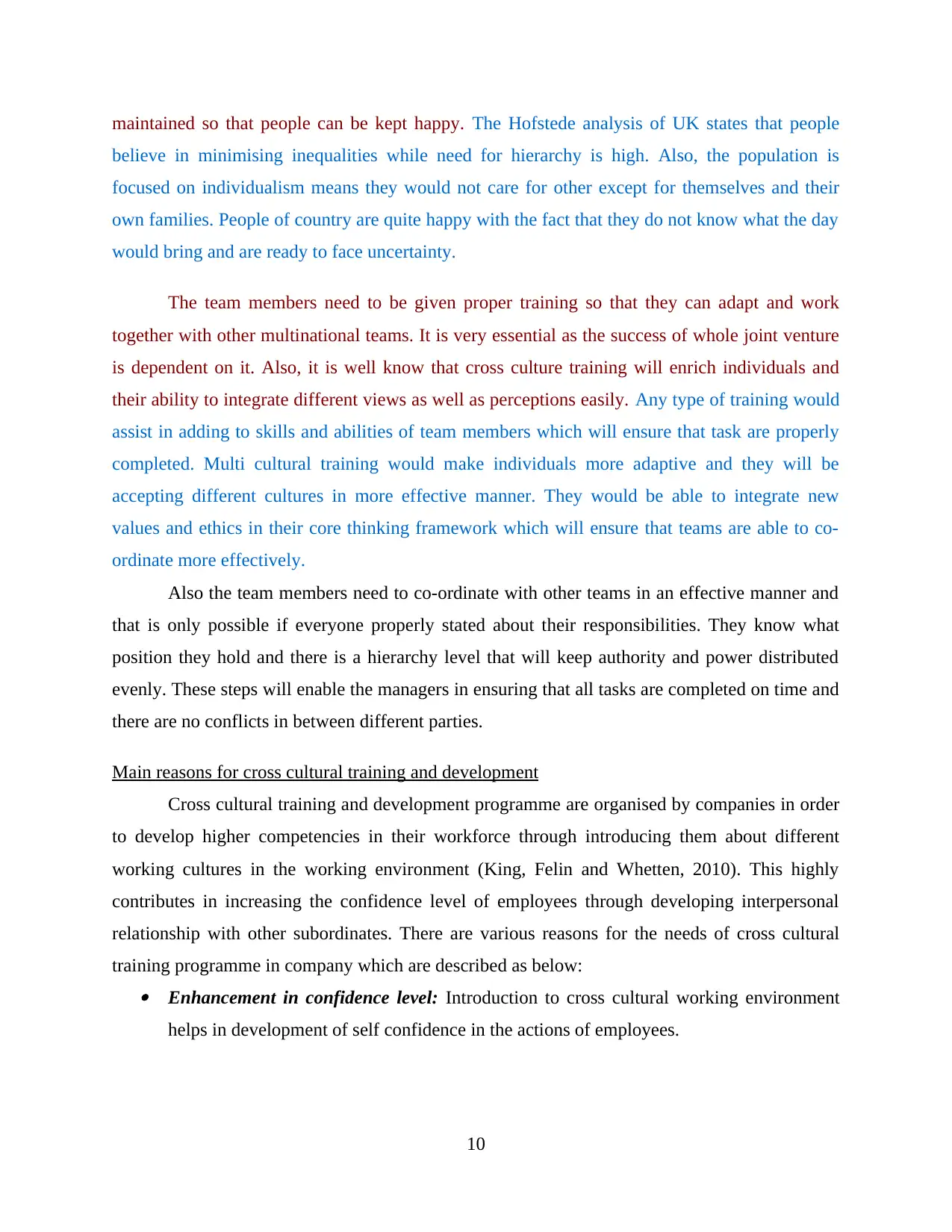
maintained so that people can be kept happy. The Hofstede analysis of UK states that people
believe in minimising inequalities while need for hierarchy is high. Also, the population is
focused on individualism means they would not care for other except for themselves and their
own families. People of country are quite happy with the fact that they do not know what the day
would bring and are ready to face uncertainty.
The team members need to be given proper training so that they can adapt and work
together with other multinational teams. It is very essential as the success of whole joint venture
is dependent on it. Also, it is well know that cross culture training will enrich individuals and
their ability to integrate different views as well as perceptions easily. Any type of training would
assist in adding to skills and abilities of team members which will ensure that task are properly
completed. Multi cultural training would make individuals more adaptive and they will be
accepting different cultures in more effective manner. They would be able to integrate new
values and ethics in their core thinking framework which will ensure that teams are able to co-
ordinate more effectively.
Also the team members need to co-ordinate with other teams in an effective manner and
that is only possible if everyone properly stated about their responsibilities. They know what
position they hold and there is a hierarchy level that will keep authority and power distributed
evenly. These steps will enable the managers in ensuring that all tasks are completed on time and
there are no conflicts in between different parties.
Main reasons for cross cultural training and development
Cross cultural training and development programme are organised by companies in order
to develop higher competencies in their workforce through introducing them about different
working cultures in the working environment (King, Felin and Whetten, 2010). This highly
contributes in increasing the confidence level of employees through developing interpersonal
relationship with other subordinates. There are various reasons for the needs of cross cultural
training programme in company which are described as below: Enhancement in confidence level: Introduction to cross cultural working environment
helps in development of self confidence in the actions of employees.
10
believe in minimising inequalities while need for hierarchy is high. Also, the population is
focused on individualism means they would not care for other except for themselves and their
own families. People of country are quite happy with the fact that they do not know what the day
would bring and are ready to face uncertainty.
The team members need to be given proper training so that they can adapt and work
together with other multinational teams. It is very essential as the success of whole joint venture
is dependent on it. Also, it is well know that cross culture training will enrich individuals and
their ability to integrate different views as well as perceptions easily. Any type of training would
assist in adding to skills and abilities of team members which will ensure that task are properly
completed. Multi cultural training would make individuals more adaptive and they will be
accepting different cultures in more effective manner. They would be able to integrate new
values and ethics in their core thinking framework which will ensure that teams are able to co-
ordinate more effectively.
Also the team members need to co-ordinate with other teams in an effective manner and
that is only possible if everyone properly stated about their responsibilities. They know what
position they hold and there is a hierarchy level that will keep authority and power distributed
evenly. These steps will enable the managers in ensuring that all tasks are completed on time and
there are no conflicts in between different parties.
Main reasons for cross cultural training and development
Cross cultural training and development programme are organised by companies in order
to develop higher competencies in their workforce through introducing them about different
working cultures in the working environment (King, Felin and Whetten, 2010). This highly
contributes in increasing the confidence level of employees through developing interpersonal
relationship with other subordinates. There are various reasons for the needs of cross cultural
training programme in company which are described as below: Enhancement in confidence level: Introduction to cross cultural working environment
helps in development of self confidence in the actions of employees.
10
⊘ This is a preview!⊘
Do you want full access?
Subscribe today to unlock all pages.

Trusted by 1+ million students worldwide
1 out of 18
Related Documents
Your All-in-One AI-Powered Toolkit for Academic Success.
+13062052269
info@desklib.com
Available 24*7 on WhatsApp / Email
![[object Object]](/_next/static/media/star-bottom.7253800d.svg)
Unlock your academic potential
Copyright © 2020–2025 A2Z Services. All Rights Reserved. Developed and managed by ZUCOL.





